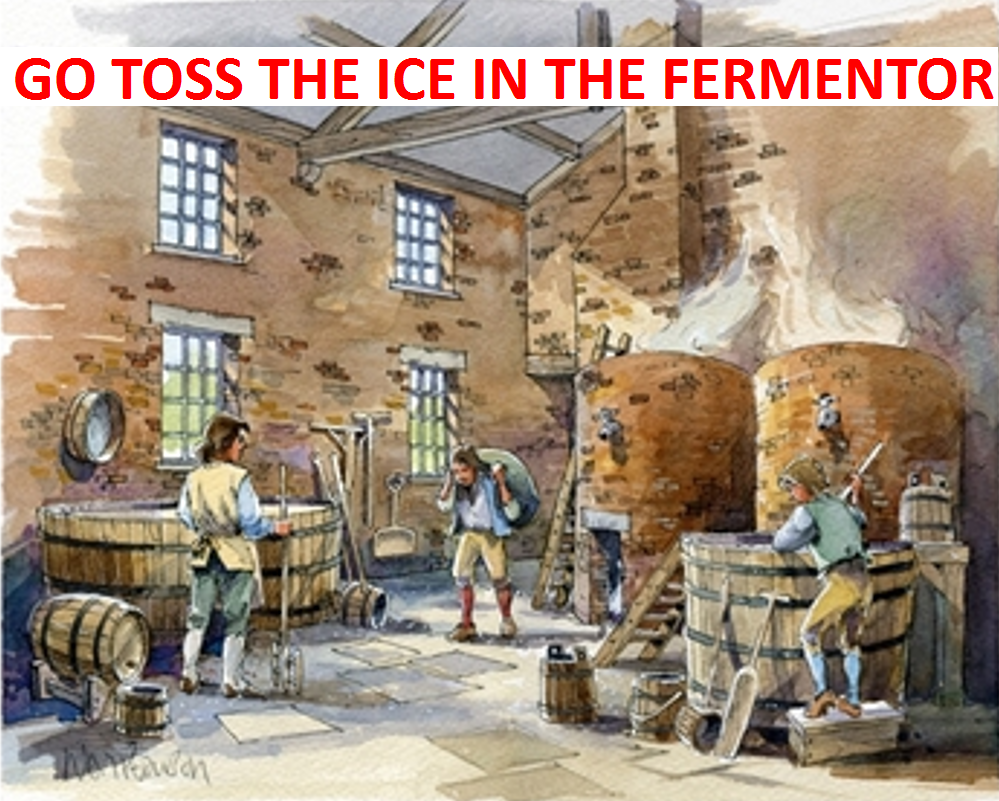Barley_Bob
Well-Known Member
I figured this out a year or two ago, and I've been doing it ever since. It works great for me, and I definitely recommend it. If it doesn't work for you, that's okay.
I will say, that it is super fast and cheap. I haven't had an infected batch, and honestly, my beer is better.
Anyway, here it is:
Step 1: Grab your copper coil chiller.
Step 2: Give it to a friend you don't like.
Step 3: Grab yourself a bag of ice from the store. (It even says on the bag "healthier than homemade"!)

Step 4: Pour the ice in your fermenter (that isn't made of glass).

Step 5: Pour your hot wort directly into the fermenter.


Step 6: Add your yeast directly from the fridge to the now ice cold wort.
(Oops too much ice. Oh well. I have bigger problems in life)

And that's it. You're done.
Additional thoughts:
1. When I brew, I use RO water from the grocery store, and I've been using that to top off when needed for years without causing infections. I just don't see how a bag of RO ice is less sanitary.
2. I really do think it makes better beer. Because the fermentation starts so slow and cold, I never have to worry about it throwing esthers at the start. I have actually left fermenters alone in a hot apartment in the summer with no ill effects. Most of the fermentation is happening when it's real cold.
3. I do worry about it taking longer to ferment and about diacetyl, so I leave it in the fermenter longer. I don't know if it's necessary. But I do it.
4. I came up with this because I've always been looking for ways cheaply and efficiently. For years, I would just let my wort cool overnight to ambient temp. Beer is really resilient, and that's a legit method too. I saw the bag of ice in my freezer and it clicked.
5. When I pour the wort into the fermenter, I do just grab the whole kettle and pour. That's not super safe. I pray first. You definitely could ladle it in or run it through a tube to be safe. Please don't burn yourself.
That's it guys. Good luck. Try it out if you think it'll help.
I will say, that it is super fast and cheap. I haven't had an infected batch, and honestly, my beer is better.
Anyway, here it is:
Step 1: Grab your copper coil chiller.
Step 2: Give it to a friend you don't like.
Step 3: Grab yourself a bag of ice from the store. (It even says on the bag "healthier than homemade"!)

Step 4: Pour the ice in your fermenter (that isn't made of glass).

Step 5: Pour your hot wort directly into the fermenter.


Step 6: Add your yeast directly from the fridge to the now ice cold wort.
(Oops too much ice. Oh well. I have bigger problems in life)

And that's it. You're done.
Additional thoughts:
1. When I brew, I use RO water from the grocery store, and I've been using that to top off when needed for years without causing infections. I just don't see how a bag of RO ice is less sanitary.
2. I really do think it makes better beer. Because the fermentation starts so slow and cold, I never have to worry about it throwing esthers at the start. I have actually left fermenters alone in a hot apartment in the summer with no ill effects. Most of the fermentation is happening when it's real cold.
3. I do worry about it taking longer to ferment and about diacetyl, so I leave it in the fermenter longer. I don't know if it's necessary. But I do it.
4. I came up with this because I've always been looking for ways cheaply and efficiently. For years, I would just let my wort cool overnight to ambient temp. Beer is really resilient, and that's a legit method too. I saw the bag of ice in my freezer and it clicked.
5. When I pour the wort into the fermenter, I do just grab the whole kettle and pour. That's not super safe. I pray first. You definitely could ladle it in or run it through a tube to be safe. Please don't burn yourself.
That's it guys. Good luck. Try it out if you think it'll help.





















![Craft A Brew - Safale BE-256 Yeast - Fermentis - Belgian Ale Dry Yeast - For Belgian & Strong Ales - Ingredients for Home Brewing - Beer Making Supplies - [3 Pack]](https://m.media-amazon.com/images/I/51bcKEwQmWL._SL500_.jpg)



















